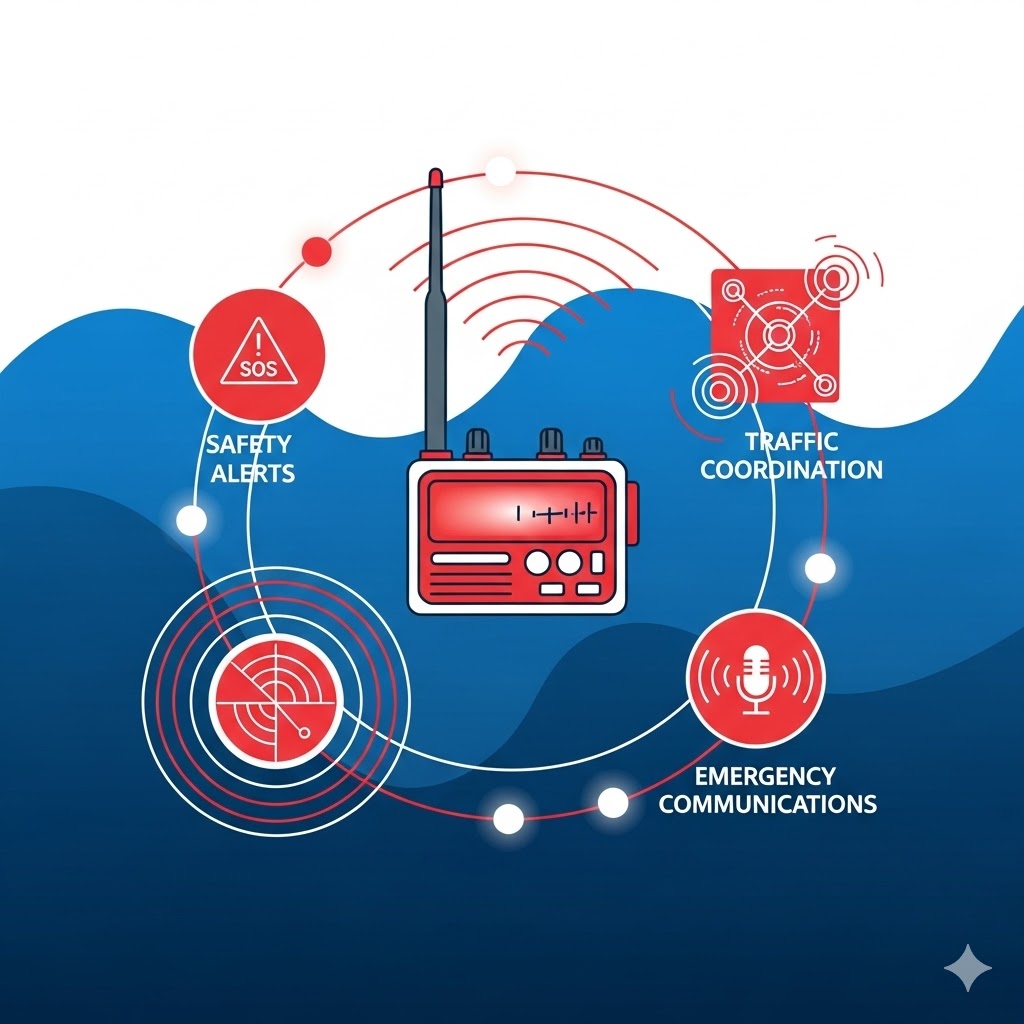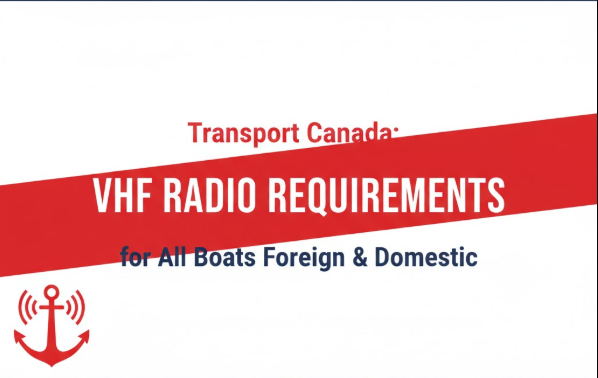Recently, Transport Canada set out specific regulatory guidance for all boats (foreign and domestic) navigating in Canadian waters. When you are managing your boat documentation through our service at National Vessel Registry Center Corp., it’s essential not only to focus on registration and licencing but also to stay compliant with operational regulations.

What Transport Canada Is Requiring
In the bulletin titled “2025 VHF marine radio channel requirements during the VHF Data Exchange System transition – SSB No.: 16/2025”, Transport Canada stated that:
- The scope covers “all vessels (foreign and domestic) navigating in Canadian waters.”
- The bulletin notes that an international initiative—VHF Data Exchange System (VDES)—is under way to modernize marine VHF radio, especially the Automatic Identification System (AIS).
- As part of this initiative, the International Telecommunication Union’s (ITU) Radio Regulations (Appendix 18, Marine Channel Plan) have been updated. Channels 24, 25, 26, 84, 85 and 86 will be designated for digital-use only starting January 1 2030.
- The bulletin highlights that some radio manufacturers have already started removing or disabling analog access to these channels in the “International” mode of shipboard radios.
- For the time being — “until further notice” — these channels remain in use for routine and safety-related voice communications in Canada, but only when the radio is set to Canadian mode (or U.S. mode) rather than International mode. Radios set in “International” mode may lack access to these channels, which is non-compliant under Canadian law.
Therefore, the key actions Transport Canada requires are:
- Before entering Canadian waters, you must verify channel availability on your radio to avoid communication gaps.
- Confirm your radio is set to Canadian channel mode (or U.S. mode where applicable), ensuring access to channels 24, 25, 26, 84, 85 and 86.
- If you are unsure how to switch modes, review your radio operating manual or contact the radio manufacturer or service provider for assistance.
- Maintain analog voice capability on those channels for now, since they are still required for operational and safety communications under Canadian regulation.

Why This Matters for Boat Operators
For anyone operating a boat in Canadian waters—whether foreign-flagged or Canadian-registered—the changes introduced by Transport Canada are significant for several reasons:
More
- Effective communication on VHF channels is a core part of marine safety. Ships and shore stations rely on designated channels to broadcast safety alerts, traffic coordination and emergency communications. If your radio cannot access the required channels you risk being unable to respond or receive critical communications.
- The transition to digital via VDES signals a shift in how maritime communications will operate in future. While we’re currently in a transition period, the fact that analog access is still required means compliance now avoids complications later.
- If your radio is set in “International” mode and lacks access to the mandated channels in Canadian waters, you may unknowingly be operating in violation of Canadian maritime laws. (For example, the bulletin states that “radio operators on vessels in Canadian waters must … confirm radios are in Canadian channel mode … All vessels navigating Canadian waters must use these channels …” )
- From an operational perspective, verifying your channel mode adds an extra step to your voyage preparation but it is relatively low effort compared to the potential safety, regulatory or insurance-related consequences.
- For commercial boating, charter, or even recreational operations with a pleasure craft licence, having compliant communications equipment aligns with best practices in vessel management and can factor into inspections or audits where applicable.
How This Applies to Registered Boats and Pleasure Craft Licence Holders
At the National Vessel Registry Center Corp., we support both boat owners engaged in full Canadian boat registration (under the Small Vessel Register or other registries) and those who hold a pleasure craft licence.
While these are different regulatory statuses, the VHF radio channel requirement from Transport Canada applies to all boats navigating Canadian waters, whether they are registered or licenced for recreational use. Here’s how:
- If your boat is registered (for example under the Canadian register or another recognized register), you are subject to operational regulatory requirements under Canadian law, including those enforced by Transport Canada for foreign and domestic boats alike. The bulletin’s language explicitly applies to “all vessels (foreign and domestic)” in Canadian waters.
- If you hold a pleasure craft licence, you may not be subject to full registration requirements but you are still operating a boat in Canadian waters. That means you must ensure your radio is set to provide access to channels 24, 25, 26, 84, 85 and 86 (as required) when in Canadian waters, if your equipment is capable of mode switching.
How Does It Work With the Small Boat Register?
- The Small Boat Register (part of the Canadian boat registration framework) likewise links to operational compliance: even though the scope of the register is limited and distinct from the pleasure craft licence regime, the communication requirements imposed by Transport Canada apply to boats irrespective of register status.
- In practical terms: if you are preparing a registration through our service, or renewing/holding a pleasure craft licence, you should simultaneously check your radio mode status and ensure you understand the upcoming transition to digital channels as signaled by Transport Canada’s bulletin.
- If you operate internationally or cross between U.S. and Canadian waters, be mindful: “International” mode on your radio may exclude access to the Canadian-mandated analog channels — so simply having a radio is not enough; its configuration matters. As the bulletin states, “Radios set to ‘International’ mode may not allow you to access these channels as Canadian law requires.”
How Our Service Supports You
At National Vessel Registry Center Corp., we make it easier for you to handle registration and licencing with confidence. While we don’t assist with collecting or installing radio equipment, we provide access to the forms for Canadian boat registration, small boat register applications, and pleasure craft licence applications. Here’s how we help:
- We offer direct access to the required registration and licencing forms (even ones for a Canadian boat mortgage as well as transcripts and historical research), which you can submit online through our portal.
- We provide guidance about regulatory updates like those from Transport Canada, so you’re aware of operational requirements such as the VHF radio channel transition.
- We enable you to manage renewals and updates efficiently—keeping your registration or licence current, which supports compliance with broader safety and regulatory obligations.
- While equipment inspection and installation are outside our scope, we remind you to verify your boat’s communication setup (radio mode, channel access) during your registration/licencing process so you’re aligned with Transport Canada’s expectations.
What Should Boat Operators Keep in Mind?
- The keyword “Transport Canada” appears often because adherence to its guidelines is critical for safe, legal boating in Canadian waters.
- As we move toward the 2030 date when those channels will become digital-only under the VDES framework, ensuring your current analog access is operative is a smart step now.
- A failure to verify radio channel accessibility may lead to communication gaps in safety or operational contexts, which could expose you to regulatory risk or increased insurance scrutiny.
- Using our portal to maintain your registration/licencing status helps you stay in sync with requirements like this, giving you more time to focus on the boating experience rather than paperwork.
Your Ally With Transport Canada
By keeping your boat registration or pleasure craft licence current through our service and making sure your communication equipment aligns with Transport Canada’s channel requirements, you position yourself for smoother operations in Canadian waters.
If you’d like help with accessing the correct forms or understanding where your registration/licencing status stands, we’re ready to assist.

